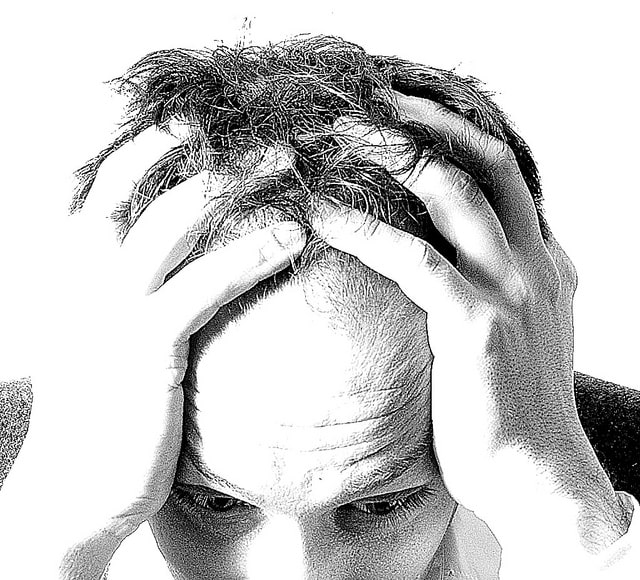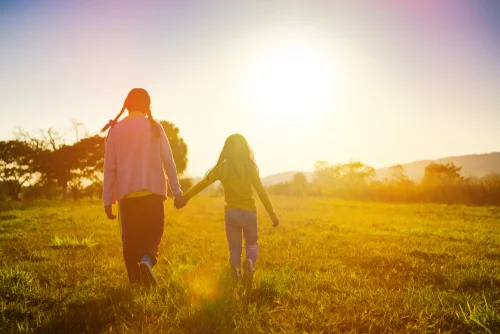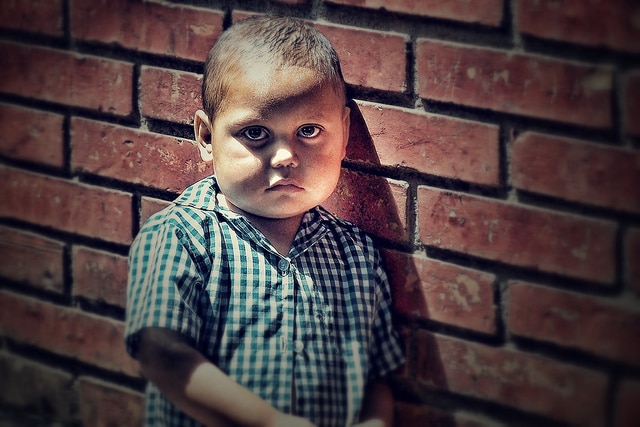The National Institute of Mental Health in the United States defines childhood trauma as, ‘’The experience of an event by a child that is emotionally painful or distressful, which often results in lasting mental and physical effects.’’
Experiencing difficult situations, and learning to cope with them, is a normal part of childhood development and growing up. However, an event, or repeated events, which leave a child fearing for their safety, can result in childhood trauma. Children may fear they are going to die or be hurt and feel like they have no control over their lives. This can happen when the child is in real physical danger but also when they witness aggression or violence in the home or wider community.
The threat – perceived or actual – can be from another individual, such as parent, a play mate or teacher, or from environmental factors. If a child experiences a natural disaster like an earthquake or hurricane, a violent accident like a car crash, or lives in a war zone or violent neighbourhood, this can lead to childhood trauma.
Therapy for childhood trauma is available but many of those in need live with the effects of trauma without ever getting a formal diagnosis or the sort of trauma treatment that could help them. There is an undisputed correlation between adult ill-health, both physical and psychological, and unresolved trauma.
The link between addiction and trauma is also now well understood. World-renowned addiction expert and physician, Dr Gabor Maté , says that a male child with six Adverse Childhood Experiences (ACEs) has a 4,600% or 46-fold increase in risk of becoming an addiction. ACEs also exponentially increase the risk of diseases e.g. cancer, high blood pressure, heart disease, etc. and also suicide and early death. Therefore, getting therapy for childhood trauma is vitally important. Without resolving trauma issues from their childhood, adults are seriously endangering their health.
The 10 main causes of childhood trauma
In the mid 1990s, a major study carried out by the Centers for Disease Control and Prevention in Atlanta, USA and the health maintenance organisation, Kaiser Permanente, looked at the association between childhood trauma and social and health problems in adulthood. The Adverse Childhood Experiences Study (ACE Study) is considered a landmark in epidemiological research and continues to inform work done today in the fields of research and therapy for childhood trauma.
The study identified ten of the most traumatic events/experiences a child is likely to encounter. The consequences of these events can be devastating and, without effect trauma therapy, can negatively impact the individual for a lifetime.
- Growing up with a parent/guardian who is an addict or who is a chronic abuser of drugs or alcohol.
- Growing up in a home where the parent or main caregiver goes to prison.
- Growing up in a home where the parent has been diagnosed with a mental illness such as schizophrenia or depression.
- Witnessing their mother being physically abused by their father or her partner
- Experiencing emotional abuse -this can range from parents being emotionally unavailable due to long working hours or their own self-absorption, to parents routinely demeaning, scaring or verbally abusing the child.
- Experiencing sexual abuse from parents, family members, other children, or anyone in a position of authority or power over the child.
- Experiencing physical abuse -either in the home by parents who use physical abuse to discipline the child, or outside the home by other authority figures.
- Losing their primary care giver or parent due to death, divorce, or abandonment.
- Living with emotional neglect -in some ways emotional neglect is the opposite of abuse or mistreatment; it’s a failure to act, an omission. Parents fail to notice or respond enough or appropriately to a child’s feelings. There is little or no emotional support or validation.
- Growing up with physical neglect -this applies when children are not adequately fed or clothed, kept clean, or kept warm in cold weather
Many children will have experienced repeated instances of several of the above examples. However, the list is not exhaustive and doesn’t include, for example, children who have lived through natural disasters or experienced the deeply traumatic impact of war.
Less obvious causes of trauma in childhood
There are some misconceptions that childhood trauma only involves physical danger or harm but in reality, anything that leaves a child feeling alone, vulnerable, overwhelmed or terrified is traumatic. Psychological trauma occurs not over the ‘facts’ of ‘what really happened’, but because of an individual’s personal experience and perspective of what happened to them. This explains why different people, both children and adults, can experience the same event and have very difficult reactions. Some may be relatively unaffected while others can develop long term, debilitating trauma or PTSD.
Experiences can be traumatic because they are unexpected and unwanted, and the child is powerless to stop them. But there are other less obvious experiences in childhood can be just as traumatic for a child and have serious consequences for the long-term.
These can be environmental situations like:
- living in poverty
- abruptly changing schools
- having a sick sibling
- going through an operation
- watching a parent being hurt
Or might be emotional traumas such as:
- a humiliating experience at school
- being bullied
- being constantly put down and shamed by a parent figure
- having to take care of a parent
- having to take care of younger siblings
Symptoms of trauma in children
Symptoms of trauma in children vary according to the age of the child; displaying some of the symptoms is not a sure sign the child is traumatised. Parents who suspect their child is experiencing trauma should have them assessed by a professional specialising in therapy for childhood trauma.
Trauma in children from birth – 2 years old
All young children and toddlers become angry or have tantrums at times. However, some of the following symptoms might indicate the child has experienced a trauma if the behaviour interferes with the child’s or family’s lives.
- Unusually high level of anger and prolonged tantrums
- Agitated and cannot be soothed
- Easily startled
- Terrified responses to stimuli that remind the child of the trauma
- Refusing to speak or being unable to speak
- Losing skills such as use of the toilet
- Fear of adults and of being separated from parent or guardian
- Development of eating issues such as loss of appetite, low weight or digestion problems
- Nightmares or sleeplessness
- Withdrawal from previously trusted adults and avoidance of physical contact
Trauma symptoms in children from 3-5 years old
In addition to the above symptoms, children in this age group may exhibit other concerning behaviours. It’s an age where children are expected to be exploring more and forming friendships with other children. Traumatised children may develop more slowly than their peers:
- Aggression or verbal abuse towards others
- Overly bossy, controlling or disruptive
- Difficulty focusing or learning
- Development of learning disabilities
- Bedwetting
- Acting out in social situations
- Unable to trust other children or adults
- Lack of self confidence
- Stomach aches and headaches
- Loneliness
- Confusion
- Unusual clinginess
- Irritability
Symptoms of trauma from 6 – 12 years old
Children are growing up and becoming more independent.They would be expected to have friends and playmates outside of the home and be integrating at school.But if they now start to develop these additional behaviours it might be time to find out if they need trauma treatment:
- School problems
- Difficulty concentrating
- Suicidal thoughts or actions
- Withdrawal from friends and family
- Acting out in social situations
- Imitating the traumatic event
- Confusion
- Drug or alcohol use
- Sexual knowledge beyond the child’s age
- Overreaction to situations
- Re-creation of the traumatic event during play
- Hoarding of food
Symptoms of childhood trauma from 13 – 18 years old

- Unusually high level of anger, aggression and verbal abuse towards others
- Suicidal thoughts or actions
- Risky behaviours, including sexual behaviours
- Unhealthy romantic relationships
- Self harm
- Panic attacks
- Flashbacks
- Running away
- Starting fights
- Trouble relating to peers
- Inability to see a future (expects to die young)
- Alienated and lonely
- Poor self esteem
The impact of trauma on childhood development
Childhood trauma can have a profound and lifelong impact on individuals who do not receive appropriate trauma treatment. Trauma and sustained stress through abuse or neglect, affect the physical structure of the brain, primarily the insula, a region deep within the cerebral cortex. The insular plays a pivotal role in, among other things, emotional regulation and self-awareness. In male children who have been who been traumatised, the insular is larger than in boys with no experience of trauma; in girls with trauma it’s smaller than those without. The discovery of these differences is important in informing trauma treatment.
Neurons are the building blocks of the brain. During development, neural networks are created and link to create brain systems. These systems are how the brain regulates all functions. Brain functions are organised from the most simple to the most complex. There are critical developmental times when neural pathways are being formed that can be significantly altered by traumatic events.
Early childhood brain development
Brain development in babies and young children lays the foundation for all subsequent development. Neural pathways form rapidly in response to repeated experiences. Early experiences teach the brain what to expect and how to respond.
When these early childhood experiences are traumatic, the neural pathways getting the most use are responding to the trauma; this reduces the formation of other pathways needed for adaptive behaviour. Trauma in early childhood can result in disrupted attachment, cognitive delays, and impaired emotional regulation.
By age three, the brain is almost 80% of its adult size. Importantly, the brain has the most plasticity in infancy and early childhood which means there is the opportunity for change. Early childhood trauma can be particularly devastating for this reason but it also means that trauma treatment and other appropriate interventions can impact the brain in positive ways.
Children and teenagers
Development of a child’s brain continues as they get older but at a slower pace. Neural pathways are consolidated and strengthened allowing school-age children to master more complex skills, including impulse control, managing emotions, and sustaining attention. Trauma during this stage of development can have significant impact on learning, social relationships, and school success. If trauma at this age has continued from early childhood then the impact on overall functioning is greater.
The impact of trauma at this age also depends on the onset. If trauma continues into the school-age years from early childhood, the impact is greater on overall functioning. There is some evidence that trauma which begins during later childhood and during teenage years will have a different impact than early childhood. In particular, trauma during later childhood/teenage years, appears to produce more externalising behaviours (acting out) when compared to early childhood trauma which often results in more internalising behaviours (withdrawal, depression, self-blame).
In adolescence the brain goes through another period of accelerated development and consolidation of neural pathways. This process makes the brain more efficient, especially the part of the brain that supports attention, concentration, reasoning, and advanced thinking. Trauma during adolescence disrupts the development of this part of the brain. This can lead to increased risk taking, impulsivity, substance abuse, and criminal activity.
Therapy for Childhood Trauma
Treating childhood trauma can be done at an outpatient or at an inpatient trauma treatment centre. Working through traumatic childhood memories can cause distress so receiving the treatment in an inpatient trauma treatment centre means the adult survivor has round the clock professional support. The aim of trauma treatment is not to erase painful memories but to greatly diminish or eliminate the emotional charge those memories carry. This in turn greatly reduces or removes the symptoms of trauma.
Recent advances in the understanding of trauma, and its psychological and physiological symptoms, have led to the research into, and development of, ever-more-effective treatment models. Some of the most effective treatments commonly used for resolving trauma include:
Eye movement desensitisation and reprogramming (EMDR)
EMDR is a highly effective method which helps trauma sufferers to properly process distressing memories. It involves bi-lateral stimulation, using eye movements or tactile stimulation, which helps to move painful memories which are ‘stuck’ in the forefront of the mind and integrate them into long term memory. EMDR is a fast-acting treatment and eight sessions is enough to significantly reduce trauma/PTSD symptoms.
Trauma resiliency model (TRM)
TRM is a body-based, or somatic therapy, which aims to reset the disrupted nervous system of those suffering from trauma. Clients are taught to observe and track their nervous system responses when they feel stressed, anxious or depressed. They learn mindfulness-based skills bring themselves back into balance when they are distressed.
Trauma release exercises (TRE)
TRE is a simple series of exercises that assist the body in releasing deep muscular patterns of stress, tension and trauma. The exercises safely activate a natural reflex mechanism of shaking or vibrating that releases muscular tension and calms down the nervous system. When this muscular shaking/vibrating mechanism is activated in a safe and controlled environment it assists the body in returning back to a state of balance.
Trauma-focused cogitative behavioural therapy (TF-CBT)
TF-CBT is a proven, short term treatment model that effectively reduces trauma and PTSD symptoms in adults and children. Based on CBT, a model that has been used to successful treat depression for fifty years, TF-CBT encourages clients to develop a “tool kit” of skills that work in different settings and for different negative feelings and encourages the child to implement affective modulation skills in response to trauma reminders.
Inpatient Trauma Treatment at The Dawn Rehab Thailand
The Dawn is an affordable rehab specialising in treating PTSD and trauma along with addiction, depression and other mental health issues. Our trauma track of treatment employs the most effective treatments available, including EMDR, TRE, TRM, and TF-CBT.
In addition, we are the only rehab in Asia and Oceania using TMS therapy, a cutting-edge medical treatment which is non-invasive and used to treat PTSD, addiction, depression and anxiety.
Alongside the psychological and medical treatments, we have a wellness programme that includes yoga, mindfulness meditation, fitness and therapeutic massage. The Dawn provides a safe and secure environment, including 24 hour medical care, where clients are supported during the challenging work of addressing their trauma issues.
Our counsellors are trauma specialists experienced in helping clients resolve childhood and adult trauma and PTDS. Contact us today for an informal chat to find out how they can help you towards a trauma-free future.


